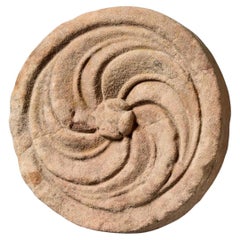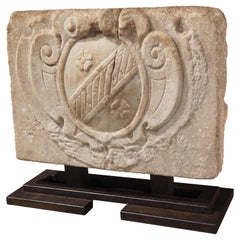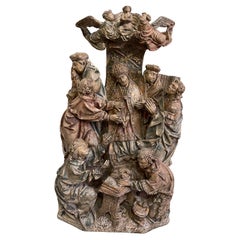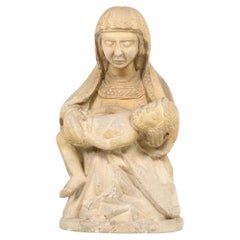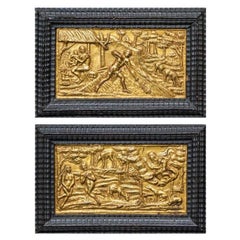16th Century Abstract Sculptures
2
to
1
1
2
2
2
65
135
4,965
6,225
184
1,679
2,448
26
2
25
52
49
290
621
955
493
285
Height
to
Width
to
2
1
1
1
1
Period: 16th Century
16th Century Carved Red Sandstone Roundel
Located in Wormelow, Herefordshire
An English medieval style carved red sandstone roundel possibly dating from as early as the 16th century. Likely once used as decoration for an exterior capital, this 400 – 500 year ...
Category
Medieval Antique 16th Century Abstract Sculptures
Materials
Sandstone
Carved and Mounted Marble Stemma Cartouche from Tuscany, Italy, 16th Century
Located in Dallas, TX
The carvings of this marble stemma cartouche dates to the 1500’s. Hand-carved in Tuscany, Italy, the marble was mounted onto a geometrically shaped iron stand within the last century...
Category
Italian Antique 16th Century Abstract Sculptures
Materials
Marble
Related Items
Early 16th Century Stone Carving - 'The Death of a Prelate'
Located in Maidstone, GB
An Early 16th Century Stone Carving with polychrome : 'The Death of a Prelate'. The enthroned figure of a Bishop surrounded by attendants and surmounted by celestial angels.
Category
European Gothic Antique 16th Century Abstract Sculptures
Materials
Stone
Spanish Sculpture "Pieta" 16th Century
Located in Madrid, ES
Spanish sculpture "Pieta"
16th century
sculpture in stone
Nossa Senhora, is represented seated securing Jesus Christ.
Measure: Height: 52 cm.
Very good condition.
Category
Spanish Gothic Antique 16th Century Abstract Sculptures
Materials
Stone
Lion of Forge, Spain, 16th Century
Located in Madrid, ES
Lion of Forge, Spain, 16th century
In forging, measurements: 10 x 17 x 5 cm
Good condition
Spanish private collection.
Category
Spanish Baroque Antique 16th Century Abstract Sculptures
Materials
Iron
16th Century English Carved Limestone Lion Statue
Located in Wormelow, Herefordshire
An English hand carved limestone lion statue possibly dating from as early as the 16th century. Made at the hand of a talented artisan, the limestone is detailed with tooling and chisel marks made by the maker throughout, depicting a small lion in a 'sejant' seated position. Though weathered throughout the ages, this 400-500 year old carving has stood the test of time, with details of the lion’s mane, paws and face recognisable to this very day. An antique artefact...
Category
English Medieval Antique 16th Century Abstract Sculptures
Materials
Stone, Limestone
Male Head, Carved Stone, Spain, 16th Century
Located in Madrid, ES
Male head. Carved stone. Century XVI.
Carved stone relief showing a male face turned to the right. It is necessary to highlight both the quality of the fac...
Category
Spanish Renaissance Antique 16th Century Abstract Sculptures
Materials
Stone
Misericord. Carved wood. 16th century.
Located in Madrid, ES
Choir Mercy. Carved wood. Century XVI.
Carved wooden Misericordia that surely belonged to a choir stall (see the upper flat part, which acts as a seat), decorated with a figurative ...
Category
European Renaissance Antique 16th Century Abstract Sculptures
Materials
Other
Saint Paul, Carved and Polychromed Wood. Spanish School, 16th Century
Located in Madrid, ES
Spanish school of the sixteenth century. "Saint Paul". Carved and polychrome wood.
Devotional image of a round piece carved in wood, polychrome and gilded, representing the Apostle ...
Category
Spanish Renaissance Antique 16th Century Abstract Sculptures
Materials
Other
Italian Ancient Marble Sculpture Fountain, Late 16th Century
Located in Milano, IT
Sea monster
Carrara marble mouth fountain
Italy, late 16th century
It measures 13.8 x 31.5 x 18.9 in (35 x 80 x 48 cm)
State of conservation: some small evident gaps and widespread signs of wear due to outdoor exposure. The gray marks crossing it do not come from restoration, but are rather the natural veins of the marble.
This work has some morphological characteristics typically associated with the iconography of the sea monster: an elongated muzzle, sharp teeth, protruding eyes, elongated ears, and a coiled serpent's tail.
An in-depth series of studies on artistic depictions of the sea monster attempted to verify how this symbol evolved in antiquity in the European and Mediterranean contexts and how it gradually changed its image and function over time. The iconography itself is mutable and imaginative and its history is rich with cultural and artistic exchange, as well as the overlapping of ideas. This occurred so much that it is difficult to accurately pinpoint the "types" that satisfactorily represent its various developments.
However, we can try to summarize the main figures, starting from the biblical Leviathan and the marine creature that swallowed Jonah (in the Christian version, this figure was to become a whale or a "big fish", the “ketos mega”, translation of the Hebrew “dag gadol”). Other specimens ranged from the dragons mentioned in the Iliad (which were winged and had legs) to "ketos” (also from Greek mythology), the terrifying being from whose Latinized name (“cetus”) derives the word "cetacean". See J. Boardman, “Very Like a Whale” - Classical Sea Monsters, in Monsters and Demons in the Ancient and Medieval Worlds, in Papers presented in Honor of Edith Porada, Mainz am Rhein 1987, pp. 73-84).
In Italy the monster underwent yet further variations: it can be found in Etruscan art on the front of some sarcophagi representing the companion of souls, while among the Romans we find the “Pistrice” (cited by Plinio in Naturalis Historia PLIN., Nat., II 9, 8 and by Virgilio in Eneide: VERG., Aen., III, 427), which appeared in the shape of a stylized hippocampus or a very large monstrous cetacean and evolved into a hideous being with a dragon's head and long webbed fins.
During the Middle Ages, the sea monster was the object of new transformations: at this time, it is often winged, the head is stretched like a crocodile, the front legs are often very sharp fins - sometimes real paws - until the image merges with dragons, the typical figures of medieval visionary spirituality widely found throughout Europe (on this topic and much more, see: Baltrušaitis, J., Il Medioevo fantastico. Antichità ed esotismi nell’arte gotica, Gli Adelphi 1997).
In Italy during the 15th and 16th centuries, the revival of classicism - representative of the humanistic and Renaissance periods - led to a different reading of these "creatures". Indeed, the sea monster was also to find widespread use as an isolated decorative motif, especially in numerous fountains and sculptures where dolphins or sea monsters were used as a characterizing element linked to water (on this theme see: Chet Van Duzer, Sea Monsters on Medieval and Renaissance Maps, London, The British library, 2013).
From the morphological point of view, the "sea monsters" of this period are mostly depicted as hybrid figures, in which the body of a mythological or real being (a hippocampus, a sea snake, a dolphin), is joined to a head with a rather indistinct appearance. It was usually characterized by large upright ears, an elongated snout, sharp teeth and globular, protruding eyes; a complex and indefinite figure, both from the symbolic point of view and from that of its genesis.
The work we are examining is placed as a cross between the medieval sea serpent and the Renaissance dolphin, with stylistic features which recall the snake as often used in heraldry (such as the "snake" depicted in the coat of arms of the Visconti - the lords and then dukes of Milan between 1277 and 1447 - and which, for some, may be derived from the representations of the “Pistrice” that swallowed Jonah).
In the search for sources, Renaissance cartography and in particular woodcuts should not be neglected. See for example the monsters of Olaus Magnus, from the editions of the “Historia de gentibus septentrionalibus” (“History of the peoples of the north”) and the natural histories of Conrad Gesner, Ulisse...
Category
Italian Renaissance Antique 16th Century Abstract Sculptures
Materials
Carrara Marble
Angel, Carved and Polychrome Wood, 16th Century
Located in Madrid, ES
Angel. Carved and polychrome wood. Century XVI.
Polychrome wood carving showing an angel, with the face facing the viewer and the body in pr...
Category
Spanish Renaissance Antique 16th Century Abstract Sculptures
Materials
Wood
Renaissance Period Hand Carved Oak Panels, 16th Century
Located in Beuzevillette, FR
Set of two 16th century oak panels, one representing a character accompanied by a dog, the other a character in flames, probably saints.
These ...
Category
French Renaissance Antique 16th Century Abstract Sculptures
Materials
Oak
16th Century Italian Renaissance Carving of a Male Saint
Located in Stamford, CT
16th century Italian carved and polychromed figure of a male saint or prophet with a wonderful presence. Shown holding an open book in his right hand with flames at his feet, mid-16t...
Category
Italian Renaissance Antique 16th Century Abstract Sculptures
Materials
Wood
A deep and well carved panel English oak 16th century
Located in Bakewell, GB
A deep and well carved panel English oak with many figures in deep relief and a good colour
Circa 1520
33cms wide x 21cms high
Category
English Antique 16th Century Abstract Sculptures
Materials
Oak
Previously Available Items
Made in 1599 Beautiful Wooden Buddha Statue / Bodhisattva / Edo Period
Located in Sammu-shi, Chiba
We have a unique Japanese aesthetic sense.
And only we can introduce unique items through our purchasing channels in Japan and the experience we have gained so far, in such a way that no one else can imitate.
It is a wood carving Buddha of 1599 in the Edo period in Japan.
I think it's Nikko Bodhisattva.
Bodhisattva is a Buddhist statue that is considered to be the second most precious being after Nyorai, the highest rank in Buddhism.
And there are different types of Nyorai, and there is a Buddhist image of medicine called "Yakushi Nyorai...
Category
Japanese Other Antique 16th Century Abstract Sculptures
Materials
Other
Mid-16th Century Pair of Reliefs with Adam and Eve Embossed Gilded Copper
Located in Milan, IT
Mid-16th century, Nuremberg pair of reliefs depicting Adam and Eve
Adam and Eve with Cain and Abel after the expulsion from Paradise
Adam...
Category
German Antique 16th Century Abstract Sculptures
Materials
Copper
H 4.61 in W 7.13 in D 1.58 in
Inca idol Statue 16th Century Stone
Located in Vosselaar, BE
This anthropomorphic statue is typical for the Inca culture under the name of Camay. These were small statuettes in stone or metal which were used as offerings and thought to emerge ...
Category
Peruvian Archaistic Antique 16th Century Abstract Sculptures
Materials
Stone
Ancient Italian Wood Gears
Located in Chicago, IL
A wonderfully sculptural ancient Italian wood gears and handle from an early clock, circa 16th century.
Category
Italian Antique 16th Century Abstract Sculptures
Materials
Wood
